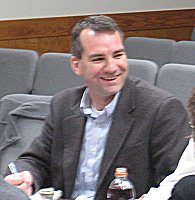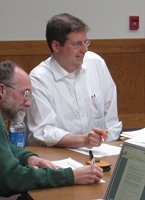- By Dan Veaner
- News
 Print
Print
Engineer Jim Blum presented preliminary data on factors that affect the cost of septic system replacement in Lansing, at Wednesday's Sewer Committee meeting. Blum's team at the engineering firm of Stearns & Wheler has been gathering the data to show how the cost of septic replacement stacks up compared to the cost of paying for a sewer system. Blum presented maps showing 50 different soil conditions in the town, soil permeability data, and a map of water table depth and rating. "We looked at the soils, bedrock, and groundwater information," Blum said. "The maps indicate areas where there might be issues with how that would impact setting up a septic system."


Tim Taber (left) will replace Jim Blum (right) as the 'face of the sewer
project.' Blum has accepted a position at Syracuse University.
There are actually two issues related to septic system replacement, price and effectiveness. Soil conditions affect both, because areas with dense clay or shallow bedrock result in more expensive septic systems to make up for the unfavorable conditions. Many such systems are deemed 'compromised systems' by the Tompkins County Health department, which defines them as systems that they are forced to accept because the size of a property or geological conditions are not favorable for meeting current standards and code. "There are a lot of areas where lot restrictions and property restrictions limit what type of system they can put in," Blum explained.
The maps depicted a surprisingly large number of areas with medium to poor conditions for septic systems. Blum says the next step will be to contact local septic contractors to get a sense of real pricing for the Lansing area. That will be put together with the information about ground conditions to predict what it would actually cost to replace a septic system in the various specific areas within the proposed sewer district. Individual residents will be able to pinpoint the projected cost for replacing a system at their own homes. That cost times the number of replacements based on the average life of a septic system over the 38 years that it will take to repay loans for building the system will be compared to the cost of the sewer system.
Committee members fear that the project will fail because taxpayers are against the cost and fear that the sewer will encourage development that will radically change the quality of life in the town. But they noted that development is coming to Lansing with or without the sewer, and that a failed project now will mean one that is twice as expensive years from now. "We may have been wrong," said Committee Chairman Bud Shattuck. "We thought it was a good idea to say this is what it costs now, but we're going to bring those numbers down. But that's the only number that's stuck."
In order to address residents' concerns the committee has pushed back the timetable, which would have called for a vote in July, but now won't happen until the end of the year. Presenting the project favorably to the public has become a priority of the committee, as well as demonstrating how judicious planning can preserve the quality of life in the town. They noted that those in favor of the sewer have been largely silent, and that has allowed the naysayers a louder voice to convince others to vote against the project. "Only a handful in the community are against it," said Councilwoman Connie Wilcox. "And that's all we hear."

Indeed town officials have been approached privately by individuals, neighborhoods, and businesses that want sewer. At a meeting two weeks ago Transonic Systems' COO Bruce Kilmartin told the committee his company will be forced to leave Lansing if a sewer isn't available to service the company's growing employee base.
But adding areas to the initial service area will be an uphill battle. Blum and attorney Mary Chappell presented a breakdown of what it would cost to add six neighborhoods, including Hillcrest Road, Water Wagon Road, Upper and lower East Lake Road, Teeter Road, and Autumn Ridge. If all six were to be added it would double the project cost, raising the part that residents would need to pay off by 250% of the cost of the currently defined initial service area. That would only add another 50% of residents and businesses served. Committee members are working on getting loans with more favorable rates as well as grants to dramatically bring down the cost of the project.
Meanwhile, Village of Lansing Mayor Don Hartill had presented an updated draft of his Memorandum of Understanding that contains a general agreement between the Village and the Town about the trunk sewer that is planned to connect the town system to the Cayuga Heights treatment plant. He went over the new language with the committee, and answered questions about a planned sewer upgrade the Village hopes to piggyback on the project to save money.
Blum announced that he will be leaving the project after next week. He has accepted a new position at Syracuse University after 17 years at Stearns & Wheler. He said that the remainder of the project team will be the same, but introduced Timothy Taber as the new 'face of the project.' Taber has been with the firm for 12 years. "I've been replaced by a younger man," Blum joked.
----
v3i14


Tim Taber (left) will replace Jim Blum (right) as the 'face of the sewer
project.' Blum has accepted a position at Syracuse University.
The maps depicted a surprisingly large number of areas with medium to poor conditions for septic systems. Blum says the next step will be to contact local septic contractors to get a sense of real pricing for the Lansing area. That will be put together with the information about ground conditions to predict what it would actually cost to replace a septic system in the various specific areas within the proposed sewer district. Individual residents will be able to pinpoint the projected cost for replacing a system at their own homes. That cost times the number of replacements based on the average life of a septic system over the 38 years that it will take to repay loans for building the system will be compared to the cost of the sewer system.
Committee members fear that the project will fail because taxpayers are against the cost and fear that the sewer will encourage development that will radically change the quality of life in the town. But they noted that development is coming to Lansing with or without the sewer, and that a failed project now will mean one that is twice as expensive years from now. "We may have been wrong," said Committee Chairman Bud Shattuck. "We thought it was a good idea to say this is what it costs now, but we're going to bring those numbers down. But that's the only number that's stuck."
In order to address residents' concerns the committee has pushed back the timetable, which would have called for a vote in July, but now won't happen until the end of the year. Presenting the project favorably to the public has become a priority of the committee, as well as demonstrating how judicious planning can preserve the quality of life in the town. They noted that those in favor of the sewer have been largely silent, and that has allowed the naysayers a louder voice to convince others to vote against the project. "Only a handful in the community are against it," said Councilwoman Connie Wilcox. "And that's all we hear."

Indeed town officials have been approached privately by individuals, neighborhoods, and businesses that want sewer. At a meeting two weeks ago Transonic Systems' COO Bruce Kilmartin told the committee his company will be forced to leave Lansing if a sewer isn't available to service the company's growing employee base.
But adding areas to the initial service area will be an uphill battle. Blum and attorney Mary Chappell presented a breakdown of what it would cost to add six neighborhoods, including Hillcrest Road, Water Wagon Road, Upper and lower East Lake Road, Teeter Road, and Autumn Ridge. If all six were to be added it would double the project cost, raising the part that residents would need to pay off by 250% of the cost of the currently defined initial service area. That would only add another 50% of residents and businesses served. Committee members are working on getting loans with more favorable rates as well as grants to dramatically bring down the cost of the project.
Meanwhile, Village of Lansing Mayor Don Hartill had presented an updated draft of his Memorandum of Understanding that contains a general agreement between the Village and the Town about the trunk sewer that is planned to connect the town system to the Cayuga Heights treatment plant. He went over the new language with the committee, and answered questions about a planned sewer upgrade the Village hopes to piggyback on the project to save money.
Blum announced that he will be leaving the project after next week. He has accepted a new position at Syracuse University after 17 years at Stearns & Wheler. He said that the remainder of the project team will be the same, but introduced Timothy Taber as the new 'face of the project.' Taber has been with the firm for 12 years. "I've been replaced by a younger man," Blum joked.
----
v3i14



